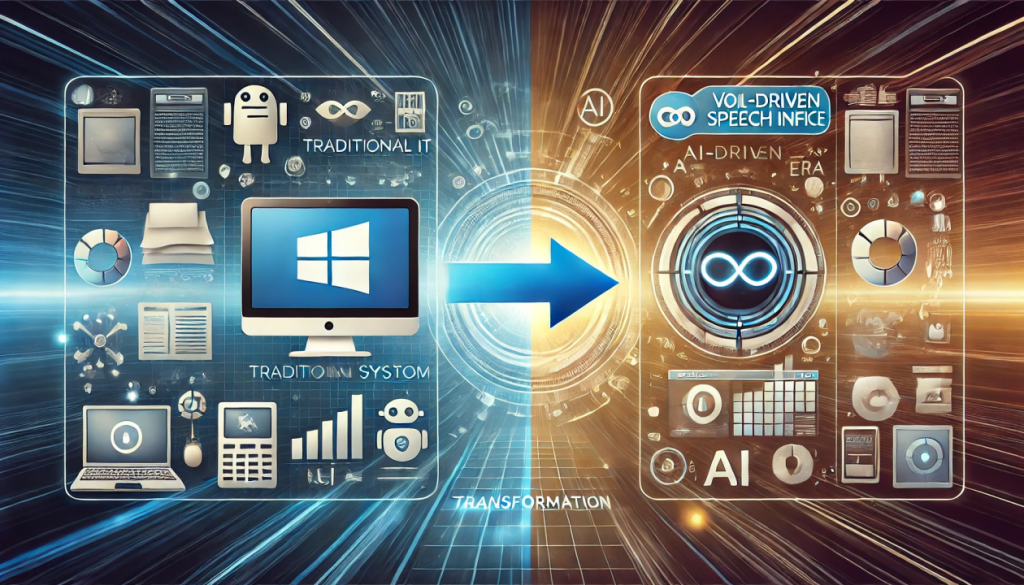The evolution of Operating Systems and Apps in an AI-Driven world
Forget Siri, ChatGPT, and Midjourney. The real AI revolution is here, and it’s not just about chatbots or image generators. Get ready for a paradigm shift in how we interact with technology, even more transformative than the mobile revolution. Large Language Models (LLMs) like ChatGPT are poised to become the new operating systems of our digital lives, the intelligent interface between us and a world of smarter machines. This isn’t just an upgrade; it’s a fundamental reimagining of how we connect, create, and communicate in the digital age.
Plain vanilla LLMs as Operating Systems
Imagine Large Language Models (LLMs) like ChatGPT, not as mere chatbots, but as the new Windows or iOS of the AI age. These powerful models serve as the foundation upon which a new generation of intelligent applications and experiences are built. They’re not just repositories of knowledge, but the underlying operating system of this emerging landscape, interpreting your commands, orchestrating tasks, and adapting to your needs.
This shift represents a profound change, akin to the transition from command-line interfaces to graphical user interfaces or mobile, making AI accessible and empowering for everyone.

RAG as the new Low-Code environments
Retrieval-Augmented Generation (RAG) is revolutionizing the way applications are built, becoming the low-code environment of the AI era.
Imagine RAG as the guardrails for LLMs by grounding their responses in specific, relevant data sources.
This means that instead of relying on the general knowledge an LLM was trained on, RAG systems can tap into real-time information from your documents, databases, or from specific web sites. This empowers power users to create highly specialized, accurate applications without having to be experts in data management or complex algorithms. By harnessing the power of RAG, developers can focus on crafting innovative solutions, while leaving the heavy lifting of data retrieval and processing to the system. This shift in focus allows for faster development cycles and more efficient applications, much like how low-code platforms democratized software development.

AI Agents as the new Applications
AI agents, like Pobuca’s Zemark, represent the next wave of intelligent applications, powered by the combined capabilities of Large Language Models (LLMs) and and targeted training in specialized domains.
These agents act as autonomous problem solvers, using LLMs to reason and make decisions based on a vast array of information sources. They seamlessly integrate with existing systems through APIs, automating complex workflows and delivering tailored solutions.
Zemark, for instance, leverages this technology to revolutionize marketing, taking on the role of a virtual agent that can create personalized campaigns, analyze customer behavior, and optimize strategies. AI agents are poised to revolutionize industries in the same way that enterprise software like ERPs and CRMs did, by automating tasks, boosting efficiency, and unlocking new opportunities. Think of AI agents as the next evolution of business applications, not just automating repetitive tasks, but actively making intelligent decisions and driving strategic initiatives.

Unlocking AI’s full potential: The synergistic dance of LLMs, RAG, and Agents
The true power of AI is unleashed when Large Language Models (LLMs), Retrieval-Augmented Generation (RAG), and AI Agents join forces. This dynamic trio forms an interconnected ecosystem where each component amplifies the capabilities of the others. LLMs serve as the intelligent foundation, RAG enriches this intelligence with contextually relevant data, and AI agents leverage this enhanced knowledge to execute tasks with remarkable efficiency and precision. This synergy not only streamlines processes but also unlocks a new realm of possibilities for innovation. Imagine a marketing team empowered by an AI agent that seamlessly analyzes market trends, leverages LLMs to understand customer preferences, and utilizes RAG to access relevant data – all to generate and execute targeted campaigns in real time. This is just a glimpse of the transformative potential that arises when these three AI technologies collaborate.

Rethinking Operating Systems and traditional software…
The convergence of Large Language Models (LLMs), Retrieval-Augmented Generation (RAG), and AI Agents heralds a transformative shift in the technological landscape. As these technologies mature and integrate, they challenge the traditional notions of operating systems, low-code platforms, and standalone applications. Instead, a new paradigm emerges where intelligent, adaptable, and interconnected AI systems become the backbone of our digital interactions. The future is not just about smarter apps or streamlined development; it’s about a fundamental reimagining of how we engage with technology, where AI becomes an integral and intuitive part of our everyday lives!
